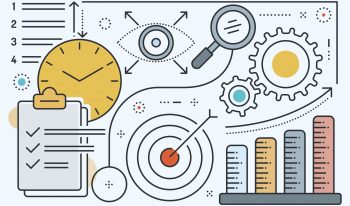Whether your responsibilities include database administration, prospect management, or stewardship activities, your days are most likely filled with the basic tasks necessary to support the success of your fundraising initiatives. For many of us, little or no time exists to pause and assess our operational infrastructure and processes to evaluate whether we are effectively managing our data, tracking activity, and using the right metrics to measure our results.
The good news is that time is now upon us. This is the perfect time to assess our operations, evaluate the integrity of our data and our system configurations, take a deep dive into our major gift portfolios, and get creative when it comes to stewardship activities.
Donor Management
Maintaining data integrity is one of the biggest challenges database administrators face today. Keeping up with the myriad responsibilities—including system updates, back-ups, record additions and changes, list management and reporting, to mention a few—is difficult at best.
Data is at the core of fundraising operations and its accuracy and consistency is critical to success. However, many organizations, if asked today, would rate the quality and integrity of their data as average. Taking the time necessary to perform a system configuration assessment and complete enhancements or clean-up activities is almost unheard of in our industry. Today and in the coming weeks and maybe months, we have an opportunity to pause and assess the way we organize our data, track our donors and prospects, document our activity, and maximize our reporting capabilities to better analyze our results. This is also a great time to create written policies and procedures if you haven’t already done so.
- Start by assessing your data integrity—are records consistently entered throughout your system?
- Are donors, prospects, board members, volunteers, leadership, and community members coded appropriately for inclusion or exclusion in your list management activities?
- Are there clean-up activities to complete in the following areas?
- Major gift portfolio balancing
- Expired pending next steps
- Expired proposal dates
- Expired gift expectancies
- Are there additional coding opportunities for donors and prospects to allow for better segmentation?
- Are you utilizing all of the reporting capabilities of your system? If not, try running some of the analytical reports you may not be familiar with and learn what the data represents.
- Does your system have dashboard capabilities and do you use them? If not, experiment with various data points and consider creating custom dashboards for each of your staff members, tailored to their roles and responsibilities.
- For healthcare organizations, are you set up to effectively track your clinician partners, referrals, and activity related to identifying, cultivating, and soliciting grateful patients and families?
Portfolio Management
As major gift officers, we are required to assume many different roles, including managing data, making calls, meeting with donors, documenting our activity, and ultimately securing contributions. Time is a luxury and adequately managing one’s portfolio is an ongoing challenge. In this time of uncertainty and change with growing numbers of individuals required to work from home and practice social distancing, we have an opportunity to concentrate on the integrity of our data and the quality of our portfolios. With the help of your prospect management staff:
- Evaluate your portfolio and determine whether you are in line with best practices in portfolio balancing.
- 30% of individuals in Discovery or Qualification
- 40% of individuals in early- or mid-Cultivation
- 30% of individuals in Solicitation
- Individuals in Stewardship would be in addition to the 100% allocation above
- Segment and code your donors’/potential donors’ status into one of the following:
- Discovery
- Qualification
- Cultivation
- Solicitation
- Stewardship
- Not Potential Donor
- Set guidelines for the acceptable time period individuals are allowed to remain in the above categories to determine if they are moving through the pipeline at an appropriate pace.
- Segment and code your potential donors into those you will:
- Solicit in the next 12 months
- Solicit in 13-24 months
- Solicit in 25-36 months
- Solicit in more than 37 months
- For those potential donors who will be solicited in the next 12 months, document a strategy and draft a written proposal when in the 3- to 6-month window of solicitation.
- For those donors in stewardship status, set an acceptable interval as a rest period and then routinely reassess those individuals whose rest period has expired for future contribution opportunities.
- If utilizing any wealth screening services or modeling processes, segment unassigned high-capacity individuals by rankings for review and potential inclusion in portfolio.
Stewardship
If your organization has invested in and mastered the art of stewardship, you are to be commended. Many institutions we work with wish they had additional resources to devote to these activities because of the important role stewardship plays in setting the stage for future contributions.
- If you don’t already have one, develop a stewardship matrix by contribution level and document all of the benefits, communications, and recognition donors receive. It will be much easier to see whether your program is adequate or if there might be opportunities for improvement either in the content or the frequency of your touchpoints.
- For most organizations, updating acknowledgement letters occurs on an annual basis. Year-end activities can be overwhelming. Oftentimes we find ourselves rushing to get everything done, including redrafting the variety of letters we need in our toolkit to say thank you to our donors. Use the days and weeks ahead to get creative and write some really thoughtful and impactful messages. If possible, prepare an inventory of letters for the future so at any time you can tap into the bank you’ve built.
- Illustrating to donors the impact of their contributions can be one of the most meaningful and powerful ways to not only say thank you but remind donors that they are truly making a difference. When we think of donor stewardship reports we often envision a full-color glossy format with an elaborate narrative. This isn’t necessary to be effective. Keep it simple and develop a one-page, front-and-back template for donor impact reports and be generous in the frequency of their use.
When these difficult times are behind us and some form of normalcy returns, having used this time for self-assessment will prove to be invaluable and ensure the foundation of your operation is strong and will adequately support your initiatives in the years to come.
Need some assistance with your database tune-up? The team at Advancement Resources can provide an expert assessment of your organization’s database and work with you to customize a system that will leverage the power of your data.


